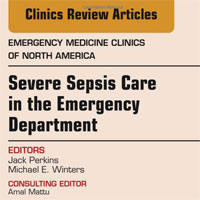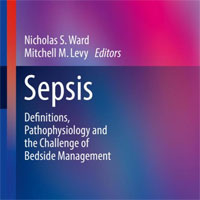Tag: resuscitation
The Fluid Debate: Balanced or Unbalanced
Consider using balanced fluids in your ED unless you are treating a patient at risk for cerebral edema, or a patient with a chloride responsive metabolic alkalosis, e.g. from gastric losses. Although the superiority of balanced... read more
AKI and Mild Therapeutic Hypothermia in Patients After Cardiopulmonary Resuscitation
The aim of this study was to investigate the influence of mild therapeutic hypothermia (MTH) on the incidence of and recovery from acute kidney injury (AKI). Mild therapeutic hypothermia seems to have a protective effect... read more
Hemodynamic Support of Pediatric and Neonatal Septic Shock
Margaret Parker, MD, MCCM, speaks with Joseph A. Carcillo, MD, about the article, "American College of Critical Care Medicine Clinical Practice Parameters for Hemodynamic Support of Pediatric and Neonatal Septic Shock," published... read more
Haemostatic Resuscitation in Trauma: The Next Generation
The next generation of haemostatic resuscitation aims at applying a ratio 1:1:1 driven strategy while using antifibrinolytics, haemostatic monitoring and avoiding critical fibrinogen deficiency by substitution. Mortality... read more
Patient Remains Awake for 90 Minutes of CPR
A man undergoing CPR, exhibited signs of conscious awareness for 90 minutes before the medical team stopped the life-sustaining procedure, according to a new case report. The 69-year-old man was admitted to a hospital in... read more
Strategies for Intravenous Fluid Resuscitation in Trauma Patients
Fluids are drugs and should be managed as such. Appropriate early fluid resuscitation in trauma patients is a challenging task. Care should be taken in selecting both the type and volume to promote appropriate perfusion and... read more
Abnormal Saline and the History of Intravenous Fluids
Two new clinical trials together involving nearly 30,000 patients support previous observational evidence that the most common solution used for intravenous fluid therapy in the world is associated with kidney damage. Both... read more
Pushing Pressors in the Periphery
The mantra of the Broome Docs site is "bringing great care, out there." And today's topic goes right to the heart of that theme. It is one of my pet topics – so apologies in advance if the rant is too long or detailed.... read more
The Ten Pitfalls of Lactate Clearance in Sepsis
Clearance is the removal of a substance from blood, expressed as a volume (milliliters) over time (minutes). However, changes in lactate levels are the sum of ongoing production and removal from the blood by excretion (e.g.,... read more
Resuscitation Sequence Intubation – Hypoxemia Kills
This blog post is the second part of a series of 3, on a recent lecture I was asked to give on Critical Care Updates: Resuscitation Sequence Intubation. This talk was mostly derived from a podcast by Scott Weingart (Twitter:... read more
Fluid Bolus Over 15-20 Versus 5-10 Minutes Each in the First Hour of Resuscitation in Children With Septic Shock
Children receiving fluid boluses over 5–10 minutes each had a higher risk of intubation than those receiving boluses over 15–20 minutes each. Notwithstanding the lack of difference in risk of mortality and the possibility... read more
When to Withdraw Resuscitation in the ED
When can and should we withdraw from continuing resuscitation in the Emergency Department? We are here to save lives. I would argue the Emergency Medicine is a very pure expression of a Doctor's role: we meet a patient, we... read more
Severe Sepsis Care in the Emergency Department
Drs. John C. Perkins and Michael E. Winters have assembled an expert team of authors on the topic of Sepsis in the Emergency Department. Article topics include: Defining and Diagnosing Sepsis; Appropriate Antibiotic Therapy;... read more

Impact of Nighttime RRT Activation on Outcomes of Hospitalized Patients with Acute Deterioration
Acutely deteriorating ward patients assessed by an RRT at nighttime had a higher risk of in-hospital mortality. This work identifies important shortcomings in health service provision and quality of care outside daytime hours,... read more
Helping Without Harming
You've been resuscitating the patient for hours and finally caught up with volume. You come back on your next shift only to find your colleague has been diuresing them all day. What the heck were they thinking!?! This normal... read more
Hemorrhagic Shock: Pearls and Pitfalls for the Resuscitation Room
Hemorrhagic shock is a state of systemic hypoperfusion secondary to acute blood loss which may have either traumatic or atraumatic etiologies. While gastrointestinal and traumatic etiologies are some of the most common causes... read more
The Right Tool for the Right Patient
Resuscitative TEE in the diagnosis of massive PE in the ED. We have multiple tools in the ed that allow us to assess patients rapidly. But of course, you must use the right tool for the patient. transthoracic echo (TTE) can... read more
Videographic Assessment of Pediatric Tracheal Intubation Technique During Emergency Airway Management
Intubators commonly exhibited suboptimal technique during tracheal intubation such as bending deeply at the waist, having their eyes close to the patient's mouth, failing to widely open the patient's mouth, and not elevating... read more
Hyperoxia and Hypocapnia During Pediatric ECMO
Hyperoxia is common during pediatric extracorporeal membrane oxygenation (ECMO) and associated with mortality. Hypocapnia appears to occur less often and although associated with complications, an association with mortality... read more
Arterial Line Placement
Approximately eight million arterial lines are placed in the United States yearly. The main indication for arterial line placement is the need for close hemodynamic monitoring. The second-to-second blood pressure variations... read more
Update of a Systematic Review of Autoresuscitation After Cardiac Arrest
Although case reports of autoresuscitation are hampered by variability in observation and monitoring techniques, autoresuscitation has now been reported in adults and children, and there appears to be a distinction in timing... read more
Tracheal Intubation During Adult In-Hospital Cardiac Arrest and Survival
This cohort study uses data from the Get With The Guidelines-Resuscitation registry to investigate the association between tracheal intubation during adult in-hospital cardiac arrest and survival to hospital discharge. In... read more









